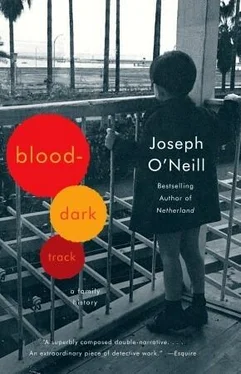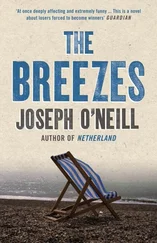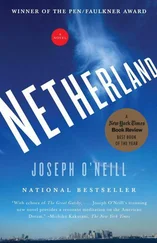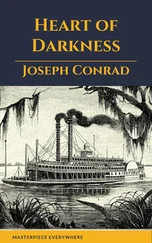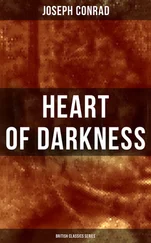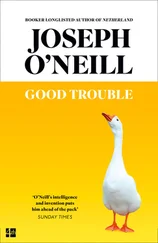Joseph O'Neill - Blood-Dark Track
Здесь есть возможность читать онлайн «Joseph O'Neill - Blood-Dark Track» — ознакомительный отрывок электронной книги совершенно бесплатно, а после прочтения отрывка купить полную версию. В некоторых случаях можно слушать аудио, скачать через торрент в формате fb2 и присутствует краткое содержание. Год выпуска: 2010, ISBN: 2010, Издательство: Knopf Doubleday Publishing Group, Жанр: Современная проза, на английском языке. Описание произведения, (предисловие) а так же отзывы посетителей доступны на портале библиотеки ЛибКат.
- Название:Blood-Dark Track
- Автор:
- Издательство:Knopf Doubleday Publishing Group
- Жанр:
- Год:2010
- ISBN:978-0-307-74265-0
- Рейтинг книги:4 / 5. Голосов: 1
-
Избранное:Добавить в избранное
- Отзывы:
-
Ваша оценка:
- 80
- 1
- 2
- 3
- 4
- 5
Blood-Dark Track: краткое содержание, описание и аннотация
Предлагаем к чтению аннотацию, описание, краткое содержание или предисловие (зависит от того, что написал сам автор книги «Blood-Dark Track»). Если вы не нашли необходимую информацию о книге — напишите в комментариях, мы постараемся отыскать её.
, a fascinating, personal, and beautifully crafted family history.
Joseph O'Neill's grandfathers-one Turkish, one Irish-were both imprisoned for suspected subversion during the Second World War. The Irish grandfather, a handsome rogue from a family of small farmers, was an active member of the IRA. O'Neill's other grandfather, a debonair hotelier from the tiny and threatened Turkish Christian minority, was interned by the British in Palestine on suspicion of being an Axis spy.
With intellect, compassion, and grace, O'Neill sets the stories of these individuals against the history of the last century's most inhuman events.
Blood-Dark Track — читать онлайн ознакомительный отрывок
Ниже представлен текст книги, разбитый по страницам. Система сохранения места последней прочитанной страницы, позволяет с удобством читать онлайн бесплатно книгу «Blood-Dark Track», без необходимости каждый раз заново искать на чём Вы остановились. Поставьте закладку, и сможете в любой момент перейти на страницу, на которой закончили чтение.
Интервал:
Закладка:
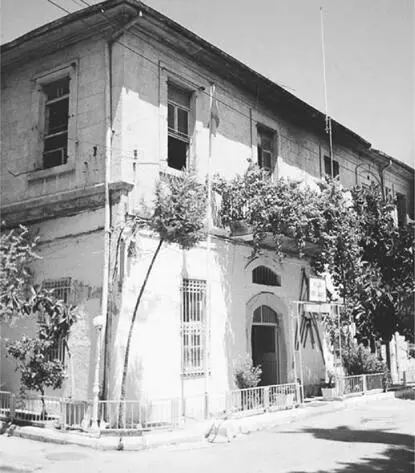
My grandfather’s childhood home
A few other places survive. An ancient Nader property is now a primary school, and in the old Maronite quarter, the house where Joseph Dakad grew up is in use as a police station.
For what it is worth, I like the new city and am excited by it. I know what fantasy and work and guts underpin its progress, I know that with its parks, shops and up-to-date facilities it is a pleasant, utilitarian and altogether desirable place to live — a model Turkish city, in many ways. But because of its modern, commercial character, Mersin has no place in western European narratives. British guide books, for example, are unanimously dismissive: ‘Can serve as an emergency stop on your way through,’ is the assessment of one book, ‘none too attractive’ and ‘almost without interest’ of others. One guide book asserts that the city was ‘little more than a squalid fishing hamlet’ at the beginning of the twentieth century, while another declares that the place did not even exist until fifty years ago.
Although Mersiners would probably find hurtful and wrong the notion that their city is nothing more than an ugly point of onward transit, it is likely that they would agree, without anxiety, with the suggestion that it has no past to speak of. Very few families have been rooted in the town for more than a generation or two, and most have histories connected to distant Anatolian villages or Kurdish mountainsides. No collective stock of stories or postcards of the old Mersin circulates, and no real interest exists in the handful of crumbling stone buildings that appear here and there, without explanation, between the apartment blocks. What matters overwhelmingly is the here and now, and so Mersin is unmythologized and ghostless, and contentedly so. Of course, it is not exempt from the generic Kemalist myth and, like every other urban settlement in the Turkish Republic, it is haunted by Atatürk, whose image, in a variety of get-ups, attitudes, silhouettes and situations, continues to adorn schools, shops, offices, homes, buses, stamps, bank notes and public spaces. (How many millions of times is a Turk fated to behold that wise, subtly pained visage?) If the past has any meaning, it is as a realm of Kemalist socio-economic progress: the only printed history of Mersin that exists, an illustrated book produced by a local lawyer, concentrates on municipal achievements like the reclamation of seaside land, the construction of the modern port, the creation of the waterfront park.
Atatürk famously visited the city in 1923. He stayed in an imposing mansion of white stone and red rooftiles that, with its ballroom, its huge mountain-facing balcony and its lush garden, was Mersin’s best shot at a palazzo. In recent years the house has been meticulously restored. Decades of grime have been scraped from its walls, shutters have been replaced and metalwork renewed. It has been named Atatürk’s House, and for a small fee visitors may stroll about its rooms to admire the enormous proportions of the building and the painted ceilings and the period furniture, and to try to envisage the great leader breakfasting here or consulting with his adjutants there or, as happened on 17 March 1923, stepping out on to the wrought-iron balcony at the front of the house and shouting at the crowd gathered below — for reasons it took me a long time to fathom — ‘People of Mersin, take possession of your town!’
A tiny and dwindling number of Mersiners will never really think of the big house as Atatürk House. For them, it will always be the Tahintzi house, the house where my uncle Fonda and his forebears lived. Fonda himself says that the house used to be known as the Christmann house, after Xenophon Christmann. The Christmann family arrived in the Levant as part of the entourage of the German Prince Athon, who was summoned to Greece in the 1830s by prospectors for a Greek royal family. Xenophon Christmann wound up as the German consul in Mersin, married Fonda’s great-aunt, and spent a chunk of his fortune on building the most magnificent building in the town. Years later, when Atatürk requisitioned the residence and the Tahintzi family standoffishly withdrew into a wing of the house, the Gazi (warrior of Islam) took offence and demanded, ‘Where is the lady of the house?’
My grandmother had a tale of this kind — a colourful jelly of small facts in which the family origins are suspended and conserved. She said that her patrilinear ancestors, the Naders, came to Turkey from Lebanon. The arrivals were two brothers from Tripoli — les grandpères , she called them both, although only one, Dimitri, was her grandfather — who were in the business of shipping timber cut from the fir and juniper forests of the Taurus Mountains to the Suez Canal. The buyers of the timber offered to pay with gold or, if the brothers preferred, shares in the Suez Canal Company. The Nader brothers chose gold, and with it they bought land in the burgeoning port of Mersin. They planted orchards and, in 1875, built two large stone houses for themselves on Mersin’s main drag. The houses formed a single immense building two stories high and a block wide, with the ground floor given over to commercial units; sixty or so years later, these premises were transformed by my grandfather into the Toros Hotel.
Such fragments of lore aside, the Christian community is fully implicated in Mersin’s general lack of retrospection. I never grew up with a clear sense of what these strange French-speaking Turks were doing in Mersin, or who they — we — really were. I knew that some families had connections with Lebanon, but I had little idea of what that meant. We were in Mersin now, and there was very little else to say.
In order to gain a picture of historic Mersin, I had to leave the city — leave Turkey, in fact — and track down the writings of travellers kept in European libraries. I read that in 1818, when Captain Beaufort went there, Mersin consisted of nothing more than a few wretched huts raised on piles. Some years later, a long-term English resident of Tarsus called William Burckhardt Barker noticed that on the slightest appearance of bad weather, Arab lombards from Syria would take shelter at a spot known as Zephyrium, or Mursina, where the roadstead was excellent. Mursina was a name derived from the Greek for myrtle, because immense bushes of that plant were practically the only thing to characterize the site. In 1838, there were only a few magazines and huts there, and bales of cotton were left out in the rain until French vessels arrived to ship them to Marseille. Barker saw an opportunity. He built large warehouses capable of holding the cargoes of fifteen vessels at one time, and soon these were filled with the produce of the hinterland for export: cotton, wool, wheat, barley, wax, sesame-seed, linseed, madder-roots, Persian yellow-berries, hides. Imports — sugar, coffee, indigo, cochineal, soap, Persian tobacco — also brought traffic to the area, and before long others had built magazines and settled there.
However, a Frenchman who visited Mersin in 1853, Victor Langlois, saw only a damned, marsh-covered, fever-devastated land with a population that decreased every year; the air was lethal, the water insalubrious, the fruit harmful. (He was not exaggerating: in the Adana plain, entire colonies of Circassian refugees, escaping from Russian anti-Muslim oppression, would be rubbed out by malarial fever.) By April 1875, things had noticeably improved. The Reverend E.J. Davis, arrived from Egypt, gained the impression of a bustling scala whose success he attributed to the active demand for cereals consequent upon the Crimean War. Mersina, as the port was known to westerners, struck the Reverend as a ‘flourishing little place; its bazaars, thronged by the various races who have settled here, present a scene of great animation; some of its streets are paved with square blocks of limestone; and there are many really good stone houses’. Officials apart, the Reverend observed, very few Turks lived in Mersin: ‘As usual in ports of these regions, Greeks and Christians of Syria are the principal inhabitants — the Greeks being energetic, enterprising, and many of them rich. The purely European residents are very few in number; an unhealthy climate and the lax commercial morality of the place, render it almost impossible for a European to thrive, or even live there.’ He noted that nearly all the Syrians spoke French — ‘it is remarkable how great an influence France has had upon the Roman Catholic population of Syria’ — and was impressed by the Greek hospital and church and, especially, the Greek school (which, forty years later, my grandmother would attend), where masters fluent in French taught ancient and modern Greek, sacred history, French, geography, arithmetic. Then, in July, when he returned to Mersin to catch a steamer home, Davis saw a dark side of the town that almost cost him his life. Descending from cool mountains, he was horrified by an intensely humid and enervating heat and the spectacle of sick people lying on mattresses at the door of their houses. To make things worse, cholera had appeared in Syria, and the service of the Russian steamers had been suspended due to a ten-day quarantine imposed by the Ottoman government on all arrivals from Syria. Davis was forced to sweat it out in Mersin. He almost didn’t make it. With the whole town in the grip of fever, and funerals passing regularly under his windows, and sleep impossible during nights he compared to a ‘damp, yet hot, oven,’ Davis fled for the relative relief of Boluklu, a village in the foothills about an hour’s ride away, where the air was marginally better. He stayed in the Mavromati house — the house, that is, of my uncle Fonda’s great-grandfather. Eventually, after eight feverish days during which he lay tormented by horrid dreams and visions, he booked a passage on a French mail steamer to Marseille and escaped Mersin’s ‘entrancing beauty and deadly air and heat’.
Читать дальшеИнтервал:
Закладка:
Похожие книги на «Blood-Dark Track»
Представляем Вашему вниманию похожие книги на «Blood-Dark Track» списком для выбора. Мы отобрали схожую по названию и смыслу литературу в надежде предоставить читателям больше вариантов отыскать новые, интересные, ещё непрочитанные произведения.
Обсуждение, отзывы о книге «Blood-Dark Track» и просто собственные мнения читателей. Оставьте ваши комментарии, напишите, что Вы думаете о произведении, его смысле или главных героях. Укажите что конкретно понравилось, а что нет, и почему Вы так считаете.
